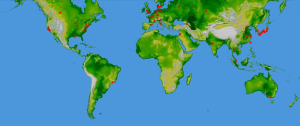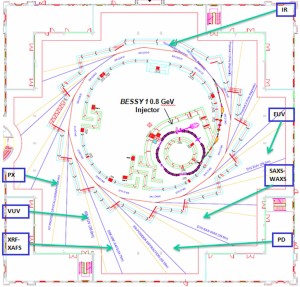Sekazi K. Mtingwa
Triangle Science, Education & Economic Development, LLC
Massachusetts Institute of Technology
African Laser Centre
Herman Winick
SLAC National Accelerator Laboratory
Stanford University
July 10, 2014
INTRODUCTION
Synchrotron radiation has revolutionized basic and applied research in many scientific and technological disciplines, leading to a proliferation of facilities around the world. The website lightsources.org has links to 47 synchrotron radiation research facilities based on electron storage rings in 23 countries in operation, construction or planning. Fig. 1 depicts the location of operating light sources worldwide. Several facilities operate more than one ring, so more than 47 rings are in operation. Also, the list of facilities in construction is not complete. For example, a 1.5 GeV facility nearing completion in Poland is not included. See
tango-controls.org/Events/meetings/october-2010/polish-synchrotron-tango-2010.10.pdf.
Figure : Locations of Synchrotron Light Sources1
More than 30,000 scientists and engineers (including thousands of students) conduct basic and applied research at synchrotron radiation facilities in many Asian countries, Australia, Brazil, Canada, many European countries, and the United States.
The lightsources.org website is a rich resource. As it says on the website “Lightsources.org contains news and science highlights from each facility, as well as photos and videos, education and outreach resources, a calendar of conferences and events, details about facility contacts and capabilities, and information on funding opportunities.” Much can be learned at this website, as well as the web sites of the facilities, and via the references provided in links enclosed in this note.
Africa is presently the only habitable continent without a synchrotron light source. Dozens of scientists from African countries now perform experiments at facilities in Europe and elsewhere. Their numbers are limited mostly by distance and travel cost. A light source in Africa would enable thousands of African scientists and engineers to gain access to this superb scientific and technological tool. Indeed, in order to be competitive socially, politically and economically in the years to come, access to a nearby synchrotron light source will be an absolute necessity.
Most present light sources are national facilities. Almost all are in over-demand, leading to construction of additional facilities to serve an increasing worldwide user community.
Two light source facilities are international. One is the 6 GeV, 850 m circumference, European Synchrotron Radiation Facility (ESRF) (esrf.eu) in Grenoble, France. This facility, a collaboration of 18 European governments, plus South Africa and Israel, has been in operation since 1992. The other is the 2.5 GeV, 130 m circumference, SESAME facility (sesame.org.jo) now in construction in the Middle East as a collaboration of 9 Middle East governments (Bahrain, Cyprus, Egypt, Iran, Israel, Jordan, Pakistan, Palestinian Authority, and Turkey). SESAME is scheduled to start research in 2016. It is closely modelled on CERN, and is being developed under the auspices of UNESCO.
SESAME and ESRF illustrate, in size and cost, the broad range of examples that might be followed for an African light source. See below for more about an intermediate energy African light source.
UNESCO became the umbrella organization for SESAME at its Executive Board 164th session, May 2002, as it did in the case of CERN in the 1950s. UNESCO’s Executive Board described SESAME as “a quintessential UNESCO project combining capacity building with vital peace-building through science” and “a model project for other regions”. It is likely that UNESCO, if asked, would play a similar role as a facilitator for an African light source.
SESAME is now well underway towards the start of research in 2016 as a fully independent intergovernmental organization. Other regions (e.g. Africa and Central Asia) are welcome to join SESAME as Members or Observers, as a first step to developing similar projects in their regions. Students and scientists from these regions are encouraged to attend SESAME Users’ meetings, schools, workshops, etc., where they can learn about synchrotron radiation sources, beamlines, and science. They are welcome to join SESAME scientists in designing and commissioning accelerators and beamlines, thereby gaining experience while helping SESAME in the process. See the end of this note for links to websites about SESAME.
SYNCHROTRON RADIATION BASICS AND AN AFRICAN LIGHT SOURCE
Synchrotron radiation is the light (electromagnetic waves) emitted by electrons as they are caused to change direction by magnets while circulating in storage rings at nearly the speed of light. It is also called “dream light” because it can be used in leading-edge scientific research and technologies. This light is produced over a broad spectral range, from infrared to hard x-rays of tens of kilovolts, enabling the use of monochromators to select a narrow band of wavelengths of interest to a particular study.
In practical situations (for example, the number of x-rays per second, within a narrow wavelength/energy band, that impinge on a sub-millimeter protein crystal) this radiation is a million to a billion times more intense than that produced by more conventional sources, such as x-ray tubes.
These storage rings range from tens of meters to 2 kilometers in circumference. They circulate and store electrons with energies from several hundred MeV to 8 GeV for several hours. The emitted radiation (by the bending magnets of these rings, or by periodic magnet arrays called wigglers and undulators inserted between the bending magnets) enters tangential beamlines that conduct the light to experimental stations. Several experimental stations receive this light at the same time, enabling many experiments (up to about 70 in the largest facilities) to be performed simultaneously.
In addition to the storage ring and beamlines, another major piece of equipment required is an injection system (a linear or circular electron accelerator), which provides electrons to fill the storage ring. Fig. 2 shows the layout of this equipment, including the 7 Phase I beamlines, in the 2.5 GeV SESAME facility.
Figure 2: Layout of Injector, Storage Ring, and Beamlines in the 2.5 GeV SESAME Project
As is evident from experience around the world, in developing countries as well as technologically advanced countries, access to a nearby synchrotron light source brings many benefits, as follows:
• Conducting world-class basic and applied research
• Training graduate students without sending them abroad
• Attracting scientists conducting research abroad to return
• Addressing regional biomedical and environmental issues/concerns
• Promoting the development of high-tech industry.
Most recently completed facilities, and those now in construction, are largely based on so-called “Intermediate Energy” electron storage rings, with energies of 2.5-3.5 GeV and circumferences of 100 to several hundred meters. By exploiting recent developments in the technology of storage rings, and wiggler and undulator insertion devices, these facilities provide, at significantly lower cost, performance closely approaching, and in some cases exceeding, that of the larger, higher energy facilities. Recent examples of intermediate energy facilities can be seen at lightsources.org.
Particularly relevant to consideration of a light source in Africa is the experience with light sources in Brazil, Korea, and Taiwan. After sending scientists to use facilities abroad, funding for light source programs in each of these countries started in the mid 1980’s, when these countries were less technologically developed than they are now. These facilities began operations in the mid 1990’s. Since then they have each trained hundreds of graduate students locally, and attracted many mid-career scientists to return home. Having seen these benefits, governments in these three countries have recently approved funding, at about the $300M level, for the construction of new, more advanced, intermediate energy (3 GeV) light sources to better serve their large and growing user communities. We are indebted to the Director of the Taiwan Light Source facility for the summary of their experience, included in the appendix to this report.
The above benefits can be realized in about a decade with aggressive planning for an African Light Source. This planning should include increasing funds available to expand the number of scientists conducting experiments abroad, and building expertise by training personnel in the latest relevant technology, including the design, construction and commissioning of storage rings, beamlines, and experimental equipment.
This approach has been successfully used in several countries, including Australia, Brazil, and Canada, which built beamlines at facilities abroad and supported their scientists to use these beamlines as a step leading to funding for their own national light sources.
We urge that training programs be initiated in Africa and partnerships be developed with light sources abroad. A particularly relevant example is the SESAME project. See:
europa.eu/rapid/press-release_IP-13-468_en.htm?locale=en
sciencediplomacy.org/perspective/2012/synchrotron-light-and-middle-east
mag.digitalpc.co.uk/fvx/iop/esrf/sesamebrochure/
bbc.co.uk/news/world-middle-east-20492294
mag.digitalpc.co.uk/fvx/iop/esrf/sesamepeople/
europa.eu/rapid/press-release_IP-13-468_en.htm?locale=en
aps.anl.gov/News/APS_News/Content/APS_NEWS_20080916.php
For more details about properties, sources, and applications of synchrotron radiation see lectures and links from the African School on Fundamental Physics – 2012 in Ghana:
indico.cern.ch/event/145296/contribution/47.
A MODEL PROGRAM FOR AFRICAN SCIENTIFIC COLLABORATIONS
Several models already exist of African countries collaborating on scientific and technological projects. One such model is the African Laser Centre (ALC). It started as a joint effort of South Africa’s National Laser Centre (NLC) and the Edward Bouchet-Abdus Salam Institute (EBASI), sponsored by the International Centre for Theoretical Physics (ICTP). From the South African side, the NLC inherited a large inventory of state-of-the-art laser equipment from a defunct uranium enrichment collaboration with France. To make full use of the laser equipment, the NLC started a loan program, whereby it granted use of the equipment to South African researchers. The program was so successful that it decided around the year 2000 to expand the program to the whole African continent. At the same time, the EBASI Council decided that it would seek ways to enhance laser research and training in Africa. Once the two efforts became known to one another, they decided to join forces and create what has become known as the African Laser Centre. It celebrated its 10th Anniversary during 2013, since the organization was officially launched on November 6, 2003, in Johannesburg, South Africa. The launching ceremony occurred during the Ministerial Segment of the New Partnership for Africa’s Development (NEPAD) Conference on Science and Technology for Development. NEPAD declared the ALC to be one of its Centers of Excellence.
The ALC, which is a virtual center, was established as a nonprofit organization, based in Pretoria. The organizers designed it to consist of nodes, where the nodes are laser laboratories in various stages of development. The most developed nodes of the network are designated as User Facilities, and they consist of the following (along with their main areas of specialization):
-
Centre de Développement des Technologies Avancées (CDTA), Algiers, Algeria
Laser spectroscopy, surface studies, laser welding
-
CSIR National Laser Centre (ALC Headquarters), Pretoria, South Africa
Manufacturing, machining, materials processing
-
National Institute of Laser Enhanced Sciences (NILES), Cairo University, Egypt
Medical and biological applications of lasers, femtosecond laser system
-
Tunis el Manar University, Tunis, Tunisia
Plant and environmental science, molecular spectroscopy
-
Laser and Fibre Optics Centre (LAFOC), University of Cape Coast, Ghana
Agricultural and environmental science
-
Laboratoire Atomes Lasers, Université Cheikh Ante Diop, Dakar, Sénégal
Atomic and molecular physics, laser spectroscopy, medical physics.
The charge to these nodes is to assist other less developed laboratories to rise to the status of User Facilities. As of 2014, the ALC has more than 30 institutional members in the countries depicted in Fig. 3.
The ALC offers a variety of programs. It provides research grants to facilitate collaborations among member institutions. It continues the NLC’s successful laser equipment loan program. It offers technical assistance to laser laboratories in order to mitigate the time loss due to equipment failures. Finally, it sponsors lectureships, postdocs, fellowships, doctoral sandwich programs, conferences, workshops, topical schools, and student internships.
1# Source: lightsources.org/cms.

